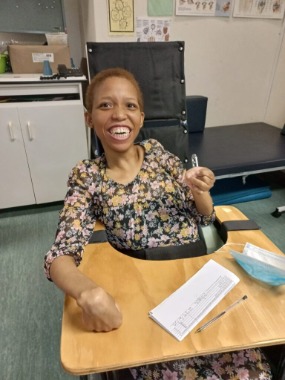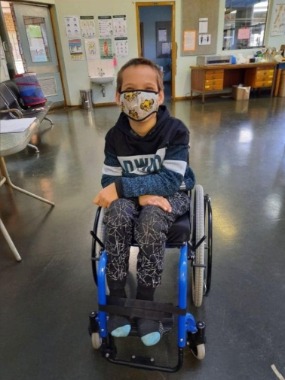
This story appears here courtesy of TheChurchNews.com. It is not for use by other media.
By Mary Richards, Church News
Mandisa Madondo in Durban, South Africa, can do so many more things now that she has received a new wheelchair with the help of Latter-day Saint Charities. The 29-year-old woman was born with cerebral palsy, and because of scoliosis and a leg-length discrepancy, she was uncomfortable and even unsafe in the oversize wheelchair she had been using.
In her new chair, she is better positioned and has the proper support for her legs. The tray table allows her to eat with her family at mealtimes. She can use her cellphone on the tray table to communicate with her mother and caregivers. Madondo is better off physically, but perhaps more importantly, she is happy.
Eight-year-old Tyler-Marc in Pietermaritzburg, South Africa, has spastic diplegia — a form of cerebral palsy in which the legs are the most affected. But the wheelchair he was using had no footplates or armrests. Volunteers in South Africa with Latter-day Saint Charities were able to help get him a new wheelchair that was fitted and appropriate for his needs.
These are just two examples shared by Elder David Nish and Sister Theresa Nish, who are South African residents and local missionaries serving with Latter-day Saint Charities. The Nishes’ efforts partnering with local organizations allowed them to find properly fitted wheelchairs for Tyler-Marc and Madondo.
A Proper Fit
Sister Nish explained that a wheelchair is not solely a mobility device: “It enables the user to interact and integrate with their family and their community on an equal footing. Loneliness is a terrible scourge, especially felt by those persons previously physically isolated from family and friends and confined to beds in back rooms, through no fault of their own.”
Latter-day Saint Charities has a long history of collaborating with local organizations to provide wheelchairs to children and adults around the world. But they don’t just give any wheelchair; the size, fit and purpose are crucial to meeting the needs of the recipients.
“We are trying to help the organizations we support in the different countries move toward a standard of care outlined in World Health Organization guidelines,” explained Eric Wunderlich, health care and disability consultant manager at Latter-day Saint Charities.
Each individual should be assessed to determine their physical needs and be provided a device that fits their environment as well, said Wunderlich. For example, do they need a wheelchair they propel or a model where they are pushed by a family member or care provider? What kind of wheels would be best for their surroundings? And what kinds of footplates, armrests or other features are beneficial? As children grow, they need to be measured for a new proper fit.
These guidelines and standards are crucial to avoiding potentially negative consequences. An improper fit could cause sores or postural deformities, which could be life-threatening. If the wheelchair isn’t comfortable or doesn’t fit well, it won’t be used. And if it doesn’t work in their environment, the individual can’t go anywhere.
WHO, a global body, issues these standards and guidelines — but Wunderlich said it is also how the Savior would serve people individually.
“I think part of the process of accessing individual needs, and determining what people need and serving people one by one, to me follows the example of the Savior,” said Wunderlich.
The Local Level

Wunderlich said Latter-day Saint Charities would like to have more people serving in the Church areas that want to have these types of programs. Having such volunteers brings the effort down to the local level, where area leaders make decisions with support and training from headquarters in Salt Lake City.
Wunderlich and the Nishes said Tyler-Marc’s and Madondo’s stories show how crucial it is for collaboration and training around properly fitted wheelchairs.
“It is indeed a great blessing to have both the opportunity and the responsibility to be the Lord’s agents for this wonderful humanitarian program,” said Sister Nish. “In turn, we also act as the wheelchair recipient’s advocate, thus enabling the fulfillment of their mobility needs. Their heartfelt and often speechless gratitude, so humbly portrayed, touches our hearts and souls.”
Copyright 2021 Deseret News Publishing Company